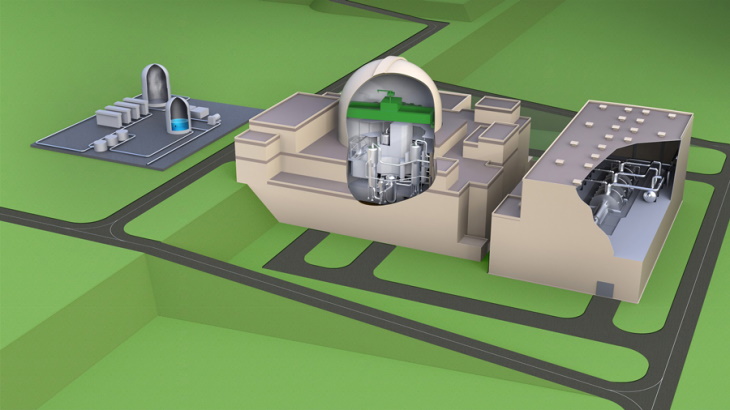Mitsubishi Heavy Industries (MHI) has launched the SRZ-1200 advanced pressurised water reactor (PWR) design. Developed in collaboration with four Japanese utilities, the 1200 MWe reactor is designed to meet the country's enhanced regulatory safety standards.

Concept of a plant based on the SRZ-1200 design (Image: MHI)
MHI said the SRZ-1200 has additional safety features when compared with conventional pressurised light water reactors. It has been designed based on enhanced Japanese regulatory safety standards which incorporate lessons learned from the March 2011 accident at the Fukushima Daiichi plant. MHI said the design will ensure the regulatory requirements of "strengthening safety equipment" and "resistance to natural disaster and security against terrorism and unforeseen event" are fulfilled.
Low-probability postulated events are still accounted for in the reactor design, MHI said, to ensure plant and public safety. These safety mechanisms include, but are not limited to, an advanced accumulator design, and systems which effectively reduce the probability of radioactivity release in the event of a postulated accident. Efforts of this nature and the resultant SRZ-1200 design features will limit any impact to the public and plant site, it said.
In addition, the SRZ-1200 design is intended to enhance operational flexibility, which will effectively allow for improved electrical power delivery alongside variable electric power sources, such as renewables.
"The ability to adapt the SRZ-1200 for hydrogen production will also be studied to ensure that all potential uses of energy generated from this plant are efficiently and proactively applied for all of societal needs," MHI said.
It noted that the name of the reactor design is derived from 'S' for supreme safety and sustainability, 'R' for resilience and 'Z' for zero-carbon emissions.
The SRZ-1200 has been designed in collaboration with Hokkaido Electric Power Company, Kansai Electric Power Company, Kyushu Electric Power Company and Shikoku Electric Power Company, which all have experience in operating PWR plants.
MHI has been involved in the construction and maintenance of all of the 24 PWRs in Japan and has led the efforts to restart and ensure the safe operation of the existing nuclear power plants.
The company said it intends "to take the SRZ-1200 conceptual design and proceed with basic design efforts". MHI aims to bring the new design to market "as early as possible" to "ensure new innovative nuclear technologies are available toward a stable energy supply for Japan".
"Taking into account the Fukushima Daiichi accident, MHI Group strives to continuously enhance safety through the restart of existing nuclear power plants as well as the safe and stable operation upon restart," MHI said. "This is part of our contribution to society and we intend to continue this contribution through the development of advanced light water reactors which achieve the world's highest level of safety."
Under its 2021 Medium-Term Business Plan - published in October 2020 - MHI said it planned to develop new reactor designs. It said it was working on a "next generation" light water reactor that will feature safety improvements, such as a core catcher and a radiation leak prevention system. The company said such a reactor - with a generating capacity of up to 1200 MWe - will improve compatibility with renewables by increasing "output adjustment capability". MHI said it was targeting commercialisation of the reactor in the mid-2030s.
Researched and written by World Nuclear News